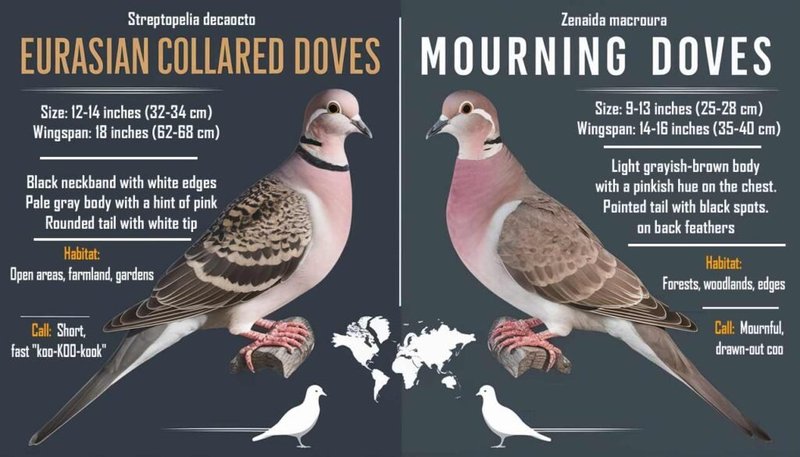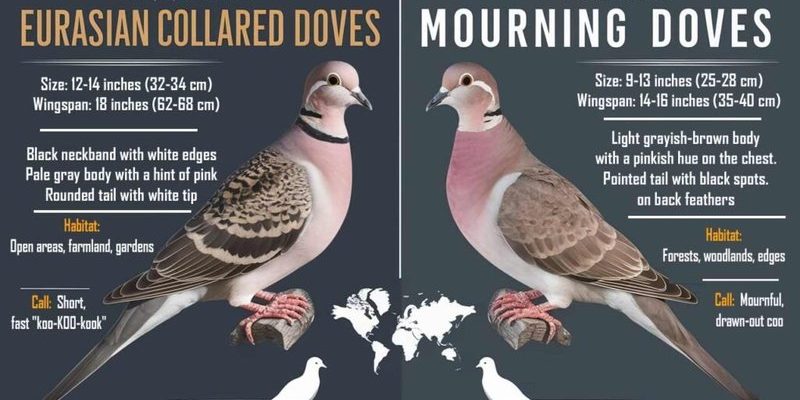
So, what exactly sets doves apart from their avian relatives? In this article, we’ll dive into a world of feathers and sounds, exploring the differences between doves and similar bird species. You might be surprised to learn that subtle differences can tell you a lot about these birds. Let’s take a closer look!
Understanding Doves: The Basics
Doves are often considered symbols of peace and love. They come in several varieties, each with its own charm. One of the most recognized types is the mourning dove, known for its soft, tragic cooing sound that brings a sense of calmness. Doves generally have a slender body, a small head, and a long, pointed tail. Their plumage varies widely, but many are adorned with soft, muted colors that help them blend into their surroundings.
These birds are typically monogamous, meaning they mate for life. After forming a bond, they’ll often be seen together, cooing softly to each other and engaging in courtship displays. Doves also tend to be gentle and shy compared to some of their more boisterous relatives, giving them a unique personality in the bird world.
Doves vs. Pigeons: A Family Affair
Now, let’s talk about one of the most common confusions: doves and pigeons. Both belong to the same family, Columbidae, and share many physical traits. However, there are some key differences.
- Size: Doves are generally smaller and more delicate than pigeons. For instance, a mourning dove can be about 9-13 inches long, while common pigeons can reach up to 15 inches.
- Coloration: While doves often have softer, pastel colors, pigeons tend to have brighter, more varied hues. Think of the iridescent neck of a pigeon compared to the understated tones of a dove.
- Behavior: Doves are typically more skittish and prefer solitary or small group settings, whereas pigeons are known for their adaptability and can thrive in larger flocks.
So, the next time you see a flock of pigeons bustling about and a dove sitting quietly nearby, you’ll know why these two are often confused yet so distinctly different!
Mourning Doves vs. Other Dove Species
When comparing mourning doves to other dove species, the differences become even more pronounced. Mourning doves are known for their unique sounds and behaviors. Here’s what sets them apart from other doves, like the rock dove or the white-winged dove.
- Sound: As previously mentioned, mourning doves have a soft, mournful coo. In contrast, the rock dove often produces a more robust and raucous sound.
- Feeding Habits: Mourning doves mainly eat seeds, foraging on the ground, while rock doves are more adept at scavenging in urban areas.
- Habitat: Mourning doves prefer open areas like fields and parks, whereas other species may thrive in rocky or urban environments.
This variety in habits and habitats really shows how adaptable these birds can be!
The Role of Doves in Different Cultures
Throughout history, doves have held significant roles in various cultures. In Christianity, they’re often seen as symbols of the Holy Spirit. In other cultures, doves are seen as messengers, carrying hope and love.
Similarly, in literature and art, doves frequently symbolize peace, love, and fidelity. They appear in numerous works, from ancient texts to modern poetry, reinforcing their importance in human expression. When you see a dove, think about how its gentle nature has impacted people for centuries.
Doves and Their Distinctive Mating Rituals
Doves are known for their intricate courtship rituals. If you’ve ever watched a pair of doves, you might have noticed their lovely dance. The male often displays a range of behaviors to attract a female, including puffing up his feathers, bowing, and producing soft cooing sounds.
Once a pair forms a bond, they will typically stay together for life. This lifelong commitment makes them stand out in the avian world. Their courtship is more than just a prelude to mating; it builds a strong partnership that supports raising their young together.
Conservation Status of Doves
While many dove species are thriving, some face threats due to habitat loss and hunting. The mourning dove, however, is one of the most populous bird species in North America. Their adaptability has helped them bounce back from past declines.
It’s essential to recognize the importance of preserving natural habitats for these birds. Conservation efforts focus on maintaining their environments and educating the public on respecting these beautiful creatures. By understanding the significance of doves in our ecosystems, we can appreciate their value even more.
Final Thoughts on Doves and Their Relatives
Doves might seem similar to other birds at first glance, but their unique traits set them apart in the avian family. From their gentle ways and distinctive sounds to their rich cultural symbolism, doves have a special place in our hearts and ecosystems.
The next time you spot a dove, whether it’s cooing softly in your backyard or soaring gracefully overhead, take a moment to appreciate its role in the world of birds. By understanding these differences, we can better protect and cherish the beauty that doves—and their relatives—bring to our lives.

